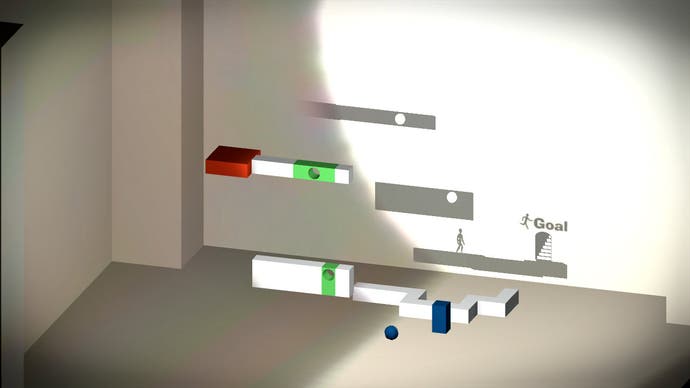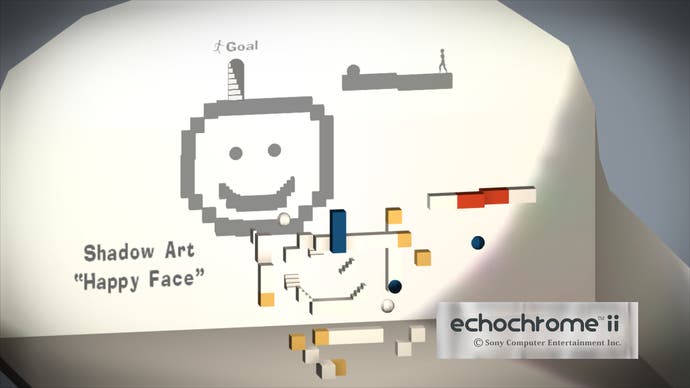echochrome ii
Light fantastic.
Failure comes if you wait out the generous time limit or if your man dies. He helpfully stands still while you move the light, but he's still at the mercy of the physics, and solid shadows can push him off a ledge to his doom or squash him between moving shadows as you swing the light source around. This becomes yet another weapon in the game's arsenal of mind-bending tricks, as one early level demonstrates how you can use the game world itself to shove our minimalist hero to the exit.
The difficulty curve steepens relatively early, but thankfully new levels are unlocked in generous batches of 10, and there are no restrictions on the order you tackle them. The problem of dead ends is also mitigated by the presence of two additional game modes, Echo and Paint.
In Echo, you have to guide your man to pick up copies of himself that loiter carelessly around the level. Paint, on the other hand, starts you off with several little men in various colours. They colour in the blocks casting the shadows they walk on, so the goal is to herd them in such a way that they cover as much ground as possible. Paint the required percentage of the level and you've won.

All game modes are played on the same layouts, giving you three ways to play any given stage. It's not only a clever way of keeping you playing through tough patches, but it helps to illustrate just how ingenious some of the level designs are, capable of supporting multiple gameplay goals using the same configuration of shapes. Indeed, working out the solution to a level in Echo or Paint often helps you see it differently, nudging a solution for the main game mode from your tortured brain.
This also gives you three different time trial leaderboards for each stage, and the game now allows you to upload video of your best efforts, either with or without PlayStation Eye footage of your scrunched up concentration face for good measure.
The level editor also returns, and is almost as challenging as the main game. Construction is easy enough, but getting your head around the numerous different ways the shadows need to fall helps you appreciate just how tricky good puzzle design can be. It also makes it difficult to create levels in the shape of giant nobs.

Move control is crisp and intuitive, and echochrome ii is no longer hampered by the fussy alignment issues that made the first game a bit of a chore. All you need to do is hold the Move button down to control the light source; that's all the input the game requires. It's a great fit with the motion technology, but not so much that it couldn't work equally well with thumbstick control schemes. Preventing the DualShock-owning masses from joining in seems a bit of a futile gesture.
Apart from that minor irritation, the only lingering criticism is that echochrome remains a curiously sterile experience. The lower case affectation, minimalist art and gentle music give it a relaxing air, but for a game that can be so quietly brilliant in its design, it seems a shame to lock it away in such a personality-free shell. Not that it would be enhanced by wacky characters or zany mini-games, but it's sometimes chilled out to the point of anonymity.
But consider how much echochrome ii gets right. It's a game that dares to tear up the rulebook and start over in the quest for a better sequel, and is all the better for venturing beyond the boundaries established in the previous game. The sort of old-school puzzle game that demands patience and dedication, it repays both in abundance.








